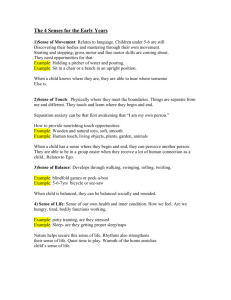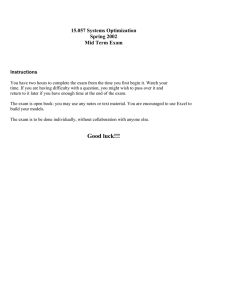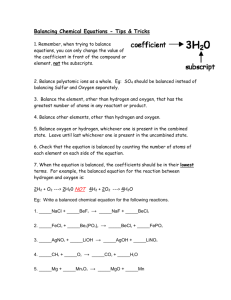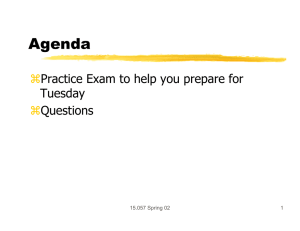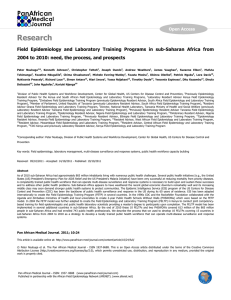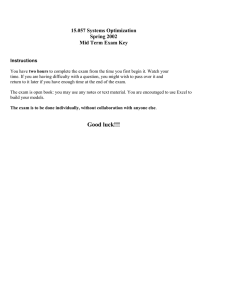Lecture 15 (Nov. 5)
advertisement
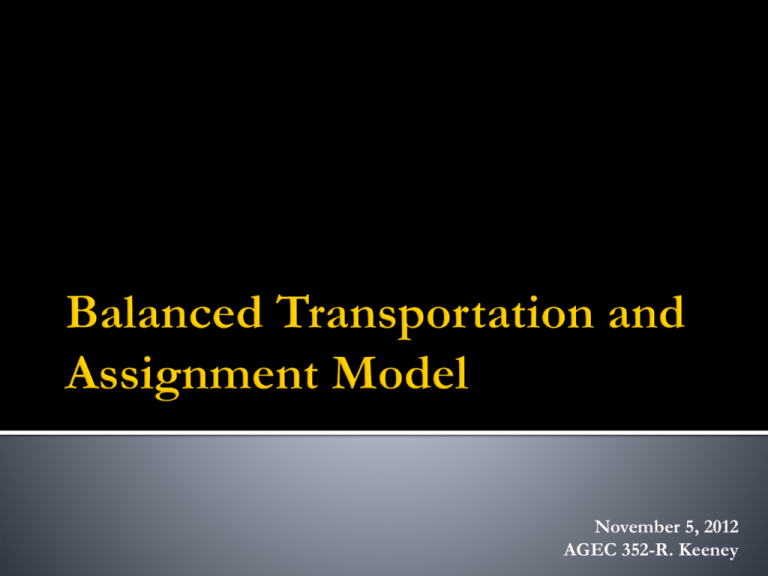
November 5, 2012 AGEC 352-R. Keeney Recall With 2000 total units (maximum) at harbor and 2000 units (minimum) demanded at assembly plants it is not possible for slack constraints Supply <=2000 Demand >=2000 Supply = Demand Total movement of 2000 motors is the only feasible combination, leading all constraints to bind One binding constraint is trivial Transportation problems do not have to be balanced Real world problems are rarely balanced If you have an unbalanced model, might want to balance it with other activities If Supply > Demand introduce a storage destination that takes up the excess What is the cost of holding excess supply? ▪ Storage costs or waste/spoil If Demand > Supply introduce a penalty source that deals with the imbalance What is the cost of shipping less than required? ▪ Lost customers or contract penalties If the constraints have integers on RHS the optimal solution will have transport quantities in integers This can be shown mathematically Convenient for solving smaller problems by hand Choose a route to enter the model, then keep adding until you hit the supply or demand constraint In a balanced problem, one constraint is mathematically redundant This is the trivial constraint and it is the one with the constraint that binds (LHS=RHS) but has a zero shadow price The assignment problem is the mathematical allocation of ‘n’ agents or objects to ‘n’ tasks The agents or objects are indivisible ▪ Each can be assigned to one task only Example using Autopower Company: Auditing the Assembly Plants @ Leipzig, Nancy, Liege, Tilburg A VP is assigned to visit and spend two weeks conducting the audit VP’s of Finance, Marketing, Operations, Personnel Considerations… Expertise to problem areas at plants Time demands on VP Language ability VP Leipzig Nancy Liege Tilburg Finance 24 10 21 11 Marketing 14 22 10 15 Operations 15 17 20 19 Personnel 11 19 14 13 How do you get those costs? Clearly when you are talking about opportunity costs and the additional cost of having someone out of their specialty or who is not a native speaker being assigned the problem a solution is heavily dependent on how reliable the opportunity cost information is Perhaps the cost of having a full-time translator or additional support staff for a VP who is dealing with a lot of problems that are not her specialty Other ways--think of skill/aptitude tests ▪ ASVAB Enumeration is a way of solving a small problem by hand Enumeration means check all possible combinations… Combinations for an ‘n’ valued assignment problem are just n factorial (n!) ▪ n = 4 n!=4*3*2*1=24 That’s still a lot to check There are other tempting methods Start with the lowest costs and work your way up? Tempting and seems logical but does not guarantee you an optimal solution for a small problem we can find the best solution using tradeoffs Think of the destinations as demanding VP with the lowest cost VP being the preference Leipzig prefers Personnel Nancy prefers Finance Liege prefers Marketing Tilburg prefers Finance Two locations have Finance as a first preference, this is the only thing that makes this problem interesting Tradeoff 1: 1000 improvement Tradeoff 2: 6000 worse Tradeoff 3: 2000 improvement Hopefully this convinces you that LP might be easier for solving these types of problems than wrangling all of the potential tradeoffs that occur Setup is the same as the Balanced Transportation problem from last week Destinations are the locations or assignments with >=1 constraints Sources are the persons or objects to be assigned with <= 1 constraints What is different? Number of rows and columns are the same (i.e. square and balanced) ▪ Not the case for transportation problems Let X i , j be the amount of i assigned to j min C i i, j X i, j j s.t. Assignees : X i, j 1 i j Assignment s : X i , j 1 j i Non - neg. : X i , j 0 i and j Recall the problem from Monday’s lecture of assigning VP’s to plants to be audited Objective We want to minimize the cost of sending Vice Presidents to assembly plants given the per unit costs matrix C(i,j) Assignees The sources For any assignee i, that assignee can be placed in a maximum of one assignment Assignments The destinations For any destination j, the assignment requires that at least one assignee be put in place Non-negativity Decision variables must be zero or positive Since the problem is balanced and assignments are 1 to 1 (1 person to 1 place) Decision variables will all have an ending value of either 1 or 0 Recall that balanced transport problems have integer solutions if RHS are integer values In general, the assignment model can be formulated as a transportation model in which supply at each source and demand at each destination is equal to one


